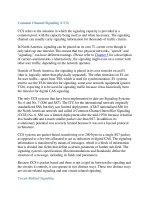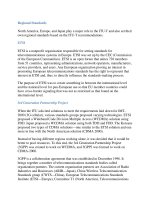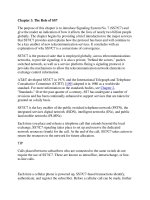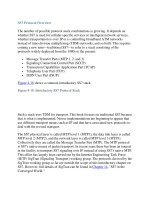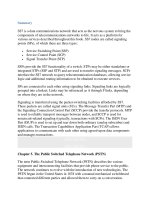Signaling System No.7 Protocol Architecture And Sevices part 6 docx
Bạn đang xem bản rút gọn của tài liệu. Xem và tải ngay bản đầy đủ của tài liệu tại đây (44.89 KB, 9 trang )
Regional Standards
N
orth America, Europe, and Japan play a major role in the ITU-T and also set their
own regional standards based on the ITU-T recommendations.
E
TSI
ETSI is a nonprofit organization responsible for setting standards for
telecommunications systems in Europe. ETSI was set up by the CEC (Commission
of the European Communities). ETSI is an open forum that unites 728 members
from 51 countries, representing administrations, network operators, manufacturers,
service providers, and users. Any European organization proving an interest in
p
romoting European telecommunications standards has the right to represent that
interest in ETSI and, thus, to directly influence the standards-making process.
The purpose of ETSI was to create something in between the international level
and the national level for pan-European use so that EU member countries could
have cross-border signaling that was not as restricted as that found on the
international level.
3rd Generation Partnership Project
When the ITU solicited solutions to meet the requirements laid down for IMT-
2000 (3G cellular), various standards groups proposed varying technologies. ETSI
p
roposed a Wideband Code Division Multiple Access (WCDMA) solution using
FDD. Japan proposed a WCDMA solution using both TDD and FDD. The Koreans
p
roposed two types of CDMA solutions—one similar to the ETSI solution and one
more in line with the North American solution (CDMA 2000).
Instead of having different regions working alone, it was decided that it would be
better to pool resources. To this end, the 3rd Generation Partnership Project
(3GPP) was created to work on WCDMA, and 3GPP2 was formed to work on
CDMA-2000.
3GPP is a collaboration agreement that was established in December 1998. It
brings together a number of telecommunications standards bodies called
organization partners. The current organization partners are Association of Radio
Industries and Businesses (ARIB—Japan), China Wireless Telecommunication
Standards group (CWTS—China), European Telecommunications Standards
Institute (ETSI—Europe), Committee T1 (North America), Telecommunications
Technology Association (TTA—Korea), and Telecommunication Technology
Committee (TTC—Japan). The Telecommunications Industry Association (TIA—
N
orth America) is an observer to 3GPP.
The scope of 3GPP was subsequently amended to include the maintenance and
development of the Global System for Mobile communication (GSM), General
Packet Radio Service (GPRS), and Enhanced Data rates for GSM Evolution
(EDGE). Previously, it focused only on developing standards for third-generation
mobile systems. The GSM standard has been transferred to 3GPP from ETSI,
although the vast majority of individual member organizations in 3GPP come from
the ETSI membership list.
3GPP's third-generation systems operate in at least the five regions of the partner
standards bodies—this is a big improvement over the GSM situation, which is
incompatible with the Japanese second-generation system and, in terms of
frequency band employed, even the GSM implementations in the U.S. The
advantages of this multiregional approach are no doubt why 3GPP was formed.
3rd Generation Partnership Project 2
3GPP2 is to CDMA-2000 what 3GPP is to W-CDMA. Furthermore, 3GPP2 was
created in the image of 3GPP. They develop 3G standards for carriers that
currently have CDMA systems (such as IS-95 or TIA/EIA-95) installed. This
group works closely with TIA/EIA TR-45.5, which originally was responsible for
CDMA standards, as well as other TR-45 subcommittees—TR-45.2 (network),
TR-45.4 ("A" interface), and TR-45.6 (packet data).
ETSI is not involved in any way with 3GPP2, and it does not publish the output of
3GPP2. Although 3GPP and 3GPP2 are separate organizations, they cooperate
when it comes to specifying services that ideally should be the same (from the
users' perspective), regardless of infrastructure and access technology. It should
also be noted that quite a few equipment manufacturers need to keep their fingers
in all pies and consequently are members of both projects. The five officially
recognized standards-developing organizations that form the 3GPP2 collaborative
effort (organization partners) are ARIB, CWTS, TIA/EIA, TTA, and TTC. In
addition, market representation partners are organizations that can offer market
advice to 3GPP2. They bring to 3GPP2 a consensus view of market requirements
(for example, services, features, and functionality) falling within the 3GPP2 scope.
These organizations are the CDMA develop group (CDG), the Mobile Wireless
Internet Forum (MWIF), and the IPv6 forum.
3GPP2 is the culmination of efforts led by ANSI, TIA/EIA, and TIA/EIA TR-45.
TIA/EIA has been chosen to be secretariat to 3GPP2. Observers from ETSI,
Telecommunications Standards Advisory Council of Canada (TSACC), and China
p
articipate in 3GPP2.
< Day Day Up >
< Day Day Up >
National and Industry Standards
N
ational standards are based on either ITU-T standards for nationalization or
regional standards that are ITU-T standards that have been regionalized in much
the same way that national standards are produced.
A
NSI
ANSI was founded in 1918 by five engineering societies and three government
agencies. The Institute remains a private, nonprofit membership organization
supported by a diverse constituency of private-sector and public organizations.
ANSI's T1 committee is involved in the standardization of SS7. These standards
are developed in close coordination with the ITU-T.
ANSI is responsible for accrediting other North American standards organizations,
including the Alliance for Telecommunications Industry Solutions (ATIS), EIA,
and TIA.
ANSI has more than 1000 company, organization, government agency,
institutional, and international members. ANSI defines protocol standards at the
national level. It works by accrediting qualified organizations to develop standards
in the technical area in which they have expertise. ANSI's role is to administer the
voluntary consensus standards system. It provides a neutral forum to develop
p
olicies on standards issues and to serve as an oversight body to the standards
development and conformity assessment programs and processes.
T1 Committee
The T1 Committee is sponsored by ATIS. It is accredited by ANSI to create
network interconnections and interoperability standards for the U.S.
Telcordia (Formerly Bellcore)
Before its divestiture in 1984, the Bell System was a dominant telecom service
p
rovider and equipment manufacturer. It provided most of the service across the
U.S. and set the de facto standards for the North American telecommunications
network.
Bell Communications Research (Bellcore) was formed at divestiture in 1984 to
p
rovide centralized services to the seven regional Bell holding companies and their
operating company subsidiaries, known as Regional Bell Operating Companies
(RBOCs). Bellcore was the research and development arm of the former Bell
System (the "baby Bells") operating companies. It defined requirements for these
companies. These were documented in its Technical Advisories (TA series),
Technical References (TR series), and Generic Requirements (GR series).
Although Bellcore specifications are somewhat prevalent in the
telecommunications industry, they are not prescribed standards, although they had
often become the de facto standards. This is because they were originally created
in a closed-forum fashion for use by the RBOCs. Even post-divestiture, the
specifications remain focused on the interests of the RBOCs. As such, they are
industry standards but are not national standards.
Bellcore was acquired by Science Applications International Corporation (SAIC)
in 1997 and was renamed Telcordia Technologies in 1999. Although Telcordia was
p
reviously funded by the RBOCs, it now operates as a regular business, providing
consulting and other services. The Telcordia specifications are derived from the
ANSI specifications, but it should be noted that Telcordia has often been a driver
for the ANSI standards body.
The core ANSI standards [1
-4] and the Bellcore standards [113] for SS7 are nearly
identical. However, Bellcore has added a number of SS7 specifications beyond the
core GR-246 specifications for RBOCs and Bellcore clients.
TIA/EIA
TIA is a nonprofit organization. It is a U.S. national trade organization with a
membership of 1000 large and small companies that manufacture or supply the
p
roducts and services used in global communications. All forms of membership
within the organization, including participation on engineering committees, require
corporate membership. Engineering committee participation is open to
nonmembers also. Dues are based on company revenue.
TIA represents the communications sector of EIA. TIA/EIA's focus is the
formation of new public land mobile network (PLMN) standards. It is an ANSI-
accredited standards-making body and has created most of the PLMN standards
used in the U.S. One very well-known standard is IS-41, which is used as the
Mobile Application Part (MAP) in CDMA networks in the U.S. to enable cellular
roaming, authentication, and so on. IS-41 is described in Chapter 13
, "GSM MAP
and ANSI-41 MAP." TIA/EIA develops ISs. Following the publication of an IS,
one of three actions must be taken—reaffirmation, revision, or rescission.
Reaffirmation is simply a review that concludes that the standard is still valid and
does not require changes. Revision is exactly that—incorporating additional
material and/or changes to technical meaning. Rescission is the result of a review
that concludes that the standard is no longer of any value.
If the majority of ANSI members agree on the TIA/EIA interim standard, it
becomes a full ANSI national standard. It is for this reason that IS-41 is now called
ANSI-41. IS-41 was revised a number of times and then became a national
standard. It progressed to Revision 0, then Revision A, then Revision B, then
Revision C, and then it became a nationalized standard—ANSI-41 on Revision D.
Currently it is on Revision E, and Revision F is planned.
In addition to ISs, TIA/EIA also publishes Telecommunications Systems Bulletins
(TSBs). These provide information on existing standards and other information of
importance to the industry.
TIA/EIA is composed of a number of committees that develop telecommunications
standards. The TR committees are concerned with PLMN standards. Nine TR
committees currently exist, as shown in Table 2-2
.
Table 2-2. TIA/EIA TR Committees
TIA/EIA TR Committee
Number TIA/EIA TR Committee Name
TR-8 Mobile and Personal/Private Radio Standards
TR-14 Point-to-Point Communications
TR-29 Facsimile Systems and Point-to-Multipoint
TR-30 Data Transmission Systems and Equipment
TR-32 Personal Communications Equipment
TR-34 Satellite Equipment and Systems
TR-41 User Premises Telecommunications
Requirements
TR-45 Mobile and Personal Communications Systems
Standards
TR-46 Mobile & Personal Communications 1800
Standards
A
TIS
ATIS is the major U.S. telecom standards organization besides TIA/EIA. Most
notably, it is responsible for ANSI SS7 standards. This organization was
p
reviously called Exchange Carriers Standards Association (ECSA).
B
SI
The BSI was formed in 1901 and was incorporated under the Royal Charter in
1929. BSI is the oldest national standards-making body in the world. Independent
of government, industry, and trade associations, BSI is an impartial body serving
both the private and public sectors. It works with manufacturing and service
industries, businesses, and governments to facilitate the production of British,
European, and international standards. As well as facilitating the writing of British
standards, it represents UK interests across the full scope of European and
international standards committees.
N
IC
C
The Network Interoperability Consultative Committee (NICC) is a UK
telecommunications industry committee that acts as an industry consensus group in
which specifications and technical issues associated with network competition can
be discussed. It also is a source of advice to the Director General of
Telecommunications for the Office of Telecommunications (OFTEL) on the
harmonization of interconnection arrangements.
N
ICC deals with particular issues via its interest groups, which aim
t
o represent
p
articular sectors of the industry. They include representatives of network
operators, public exchange manufacturers, terminal equipment suppliers, and
service providers. There is also a separate users' panel that works electronically to
p
rovi
d
e a user's perspective on NICC activities.
At the NICC's top level is the NICC Board, which is composed mainly of
representatives of the interest groups that form the whole NICC. PNO is the Public
N
etwork Operators interest group. Company representatives can join the
appropriate interest groups directly, but the board members are elected from the
interest group participants.
Technical issues addressed so far by the NICC include the further development of
interconnect signaling standards, methods of achieving geographic and
nongeographic number portability, and defining interfaces for service providers.
N
ICC has defined UK C7 (IUP) [40] signaling independent of British Telecom
N
etwork Requirements (BTNR) and has developed intelligent network and
database solutions for number portability.
I
ETF
The Internet Engineering Task Force (IETF) is a nonprofit organization that is
composed of a vast number of volunteers who cooperate to develop Internet
standards. These volunteers come from equipment manufacturers, research
institutions, and network operators.
The process of developing an Internet standard is documented in RFC 2026. A
brief overview is provided here. An Internet standard begins life as an Internet
Draft (ID), which is just an early specification. The draft can be revised, replaced,
or made obsolete at any time. The draft is placed in the IETF's IDs directory, where
anyone can view it. If the draft is not revised within 6 months or has not been
recommended for publication as an RFC, it is removed from the directory and
ceases to exist.
If the Internet Draft is sufficiently complete, it is published as an RFC and is given
an RFC number. However, this does not mean that it is already a standard. Before
a RFC becomes a proposed standard, it must have generated significant interest in
the Internet community and must be stable and complete. The RFC does not have
to be implemented before becoming a proposed standard.
The next step is that the RFC changes status from a proposal to a draft standard.
For this to happen, there must have been at least two successful implementations o
f
the specification, and interoperability must have been demonstrated.
The final step to turn the RFC into a standard is to satisfy the Internet Engineering
Steering Group (IESG). The IESG needs to be satisfied that the specification is
both stable and mature and that it can be successfully deployed on a large scale.
When the RFC becomes a standard, it is given a standard (STD) number, but it
retains its previous RFC number. STD 1 lists the various RFCs and is updated
p
eriodically.
One working group within the IETF that is of particular interest in relation to SS7
is Sigtran. Sigtran is concerned with the transport of signaling within IP-based
networks including ISDN, SS7/C7, and V5. It is described in Chapter 14
, "SS7 in
the Converged World." The Sigtran architecture is defined in RFC 2719,
Framework Architecture for Signalling Transport. Other RFCs and IDs relate to
Sigtran. See Appendix J
, "ITU and ANSI Protocol Comparison."


